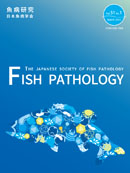
- 4 号 p. 111-
- 3 号 p. 53-
- 2 号 p. 25-
- 1 号 p. 1-
- |<
- <
- 1
- >
- >|
-
Norihiko Komatsu, Naoki Itoh, Kazuo Ogawa原稿種別: Research Article
2020 年 55 巻 3 号 p. 53-60
発行日: 2020/09/15
公開日: 2020/10/22
ジャーナル フリーIn August 2013, metacercarial infection in the abdominal cavity of Japanese dace Tribolodon hakonensis fingerlings occurred at a hatchery in Nagano Prefecture, Japan. All fish examined in this study (n = 45) were infected, and heavily infected fish showed an abnormally distended abdomen and ascites, with the number of metacercariae reaching 66. The metacercariae were distinctly bipartite, representing a Neascus type and classified as a member of Diplostomidae, and phylogenetical analyses based on ITS2 and cox1 sequences tentatively classified them in the genus Posthodiplostomum. When they were excysted, only a few were alive and intact, suggesting that dace is not a suitable host. Histopathologically, cysts containing dead worms and empty and vestigial cysts were in the abdominal cavity, detached from the host visceral organs and surrounded by host inflammatory cells. Diplostomid cercarial larvae were not found in the three species of snails (n = 613) sampled from ponds in the station. At the end of rearing in September, the survival rate was 0.96% in a pond with a high infection rate, whereas it was 12.5% in another pond where fingerlings showed no clear disease signs. Oral administration of praziquantel at 150 mg/kg fish body weight for 3 consecutive days effectively killed metacercariae in the abdominal cavity.
抄録全体を表示PDF形式でダウンロード (1180K) -
Shinya Mizuno, Shigehiko Urawa, Yoshitomo Katsumata, Takumi Morishita, ...原稿種別: Research Article
2020 年 55 巻 3 号 p. 61-70
発行日: 2020/09/15
公開日: 2020/10/22
ジャーナル フリーDiplomonad flagellate Spironucleus salmonis infection in hatchery-reared juvenile chum salmon Oncorhynchus keta and masu salmon O. masou has been previously reported in Hokkaido, northern Japan. We established a quantitative real-time PCR (qPCR) assay for the S. salmonis ribosomal RNA gene (rDNA) using a fish intestine nucleic acid template, which we then use to investigate the infection intensity of S. salmonis in hatchery-reared, farmed, and wild salmonids throughout Hokkaido. Our new qPCR assay enabled the measurement of rDNA from 1.0–1.0 × 108 copies/μL. Our study reported a significantly positive correlation between parasite trophozoite cell number and its rDNA copy number, and presented this as a simple regression (parasite rDNA copy number = -768 + 338 × parasite cell number). By reporting S. salmonis infection in juvenile and/or adult chum and masu salmon collected from three hatcheries, one fish farm, and one river in Hokkaido, we demonstrate the utility of our qPCR assay for the surveillance of S. salmonis infection in hatchery-reared, farmed and wild fish.
抄録全体を表示PDF形式でダウンロード (815K) -
Takahiro Nagai, Toshihiro Nakai原稿種別: Research Article
2020 年 55 巻 3 号 p. 71-79
発行日: 2020/09/15
公開日: 2020/10/22
ジャーナル フリーThe susceptibility of ayu Plecoglossus altivelis to infection by Flavobacterium psychrophilum differs among hatchery stocks. We challenged two ayu stocks, domesticated stock (DS) and amphidromous stock (AS), with 18 F. psychrophilum isolates derived from diseased ayu using intraperitoneal (IP) injection and immersion methods. In both methods, 6 isolates were more virulent to DS than to AS (designated as the Do pathotype), whereas the other 12 isolates were more virulent to AS than to DS (designated as the Am pathotype). The LD50s (CFU/fish) of the representative isolates, PH-1034 (Do pathotype) and PH-1037 (Am pathotype) by IP injection in DS and AS were 1.4 × 102 and 5.0 × 105, and 5.9 × 105 and 4.6 × 102, respectively. The difference in virulence between pathotypes was supported by the in vivo bacterial counts in the blood and organs of IP-challenged fish, but not by the in vitro growth ability in the serum of ayu, which is a virulence factor of F. psychrophilum. Additionally, the 18 F. psychrophilum isolates could be classified into any one of the previously reported PCR-RFLP-based genotypes. However, no clear correlation was found between these genotypes and pathotypes.
抄録全体を表示PDF形式でダウンロード (739K)
-
Effects of Hydrogen Peroxide on Egg Laying and Hatching of the Skin Monogenean Neobenedenia girellaeNoritaka Hirazawa, Naoko Umeda, Kousuke Akiyama原稿種別: Short Communication
2020 年 55 巻 3 号 p. 80-83
発行日: 2020/09/15
公開日: 2020/10/22
ジャーナル フリーThe effects of concentrations and exposure durations of H2O2 on the egg laying and egg hatching of Neobenedenia girellae were investigated. Four groups of eight adults or approximately 250 eggs were treated with H2O2 as follows: 0 ppm for 30 min (control), 300 ppm for 3 min; 75 ppm for 30 min; 100 ppm for 30 min. The adults in the H2O2 exposed groups produced significantly fewer number of normal eggs. Additionally, the H2O2 exposures to the eggs significantly reduced the hatching success of the eggs at < 24 h after laying, but the eggs at 48–71 h after laying were not affected.
抄録全体を表示PDF形式でダウンロード (590K) -
Tomoki Koyama, Daiki Komatsu, Tsubasa Uchino, Yuki Midorikawa, Goshi K ...原稿種別: Short Communication
2020 年 55 巻 3 号 p. 84-87
発行日: 2020/09/15
公開日: 2020/10/22
ジャーナル フリーPlecoglossus altivelis poxvirus-like virus (PaPV) is the presumptive causative agent of atypical cellular gill disease (ACGD), which has caused significant losses in aquaculture of ayu P. altivelis in Japan. In this study, we investigated a new PCR protocol and a quantitative PCR (qPCR) protocol with primers designed from the vaccinia virus A16L homologous gene sequence of PaPV. The new PCR showed a positive reaction for affected fish in all eight ACGD cases tested and no cross-reaction with carp edema virus, and was more sensitive than a PCR with BOKE30 primers. The qPCR quantified around 108–109 virus DNA copies/mg in the diseased fish gills.
抄録全体を表示PDF形式でダウンロード (643K)
-
八木 洋樹, 浅井 七望, 白樫 正, 岡田 貴彦, 高岡 治, 升間 主計原稿種別: 情報
2020 年 55 巻 3 号 p. 88-90
発行日: 2020/09/15
公開日: 2020/10/22
ジャーナル フリーこれまで国内外の養殖クロマグロにおいてハダムシが寄生した例は報告されていない。2020年1月に鹿児島県奄美諸島にて養成中のクロマグロ親魚の衰弱個体にハダムシの寄生が確認され,形態的特徴と遺伝子解析の結果Neobenedenia girellaeであると同定されたので報告する。本種は宿主特異性が低く,多くの海産養殖魚に寄生するが,これまで寄生が著しいカンパチと同一海域で飼育されているクロマグロでもみつかったことは無く,世界的にもマグロ類における寄生例はない。今回の事例によりN. girellaeがクロマグロにも寄生することが初めて明らかとなったが,何らかの要因で衰弱した個体で発生した例外的な寄生だと考えられた。
抄録全体を表示PDF形式でダウンロード (1323K)
- |<
- <
- 1
- >
- >|